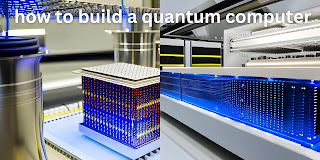Introduction:
The groundbreaking science of quantum computing has the potential to change many different sectors.You may learn how to construct a quantum computer from this manual, which also explains the underlying ideas, significant elements, and useful techniques.
Understanding the Fundamentals:
Understanding the fundamentals of quantum physics is vital before beginning the construction process. Superposition, entanglement, and quantum gates are the building blocks of quantum computing that enable the creation of exponentially powerful machines.
Key Components of a Quantum Computer:
Qubits, the quantum counterparts of classical bits, lie at the heart of quantum computing. Understanding the different types of qubits and their properties is essential. Quantum gates and operations manipulate qubits, allowing for complex computations and algorithm execution. Additionally, implementing quantum error correction techniques is crucia to preserve the fragile quantum information.
Building Blocks: How to Build a Quantum Computer:
1. Choosing a physical implementation:
Explore various physical systems such as atoms, ions, superconducting circuits, or photons.
Consider factors like stability, scalability, and ease of control.
2. Setting up a controlled environment:
Create an environment with ultra-low temperatures to minimize environmental noise an decoherence.
Implement advanced isolation techniques and shielding against external disturbances.
3. Designing qubit control systems:
Develop precise control mechanisms for manipulating qubits.
Leverage advanced technologies to achieve accurate gate operations.
4. Implementing quantum gates:
Utilize specific gate operations based on the physical implementation of qubits.
Create quantum circuits and execute quantum algorithms.
5. Quantum error correction and fault tolerance:
Implement error-detecting and error-correcting codes to protect quantum information from errors.
Develop fault-tolerant techniques to ensure reliable computations.
Challenges and Considerations:
Building a practical quantum computer comes with its own set of challenges. Overcoming decoherence and noise, scaling up the number of qubits while maintaining their stability, and improving computational speed and efficiency are critical areas of focus for researchers and engineers.
Future Developments and Quantum Computing Roadmap:
The field of quantum computing is evolving rapidly. Keep an eye on advances in quantum technologies, such as improved qubit designs, error correction techniques, and increased computational power. Quantum supremacy, the point at which quantum computers outperform classical computers, is on the horizon, promising groundbreaking possibilities.
Conclusion:
Though it is a difficult and complex task, creating a quantum computer is something that is achievable with the correct information and skills. By understanding the fundamentals, mastering the key components, and addressing the associated challenges, you can contribute to unlocking the immense power of quantum computing.
